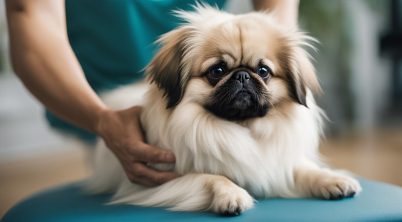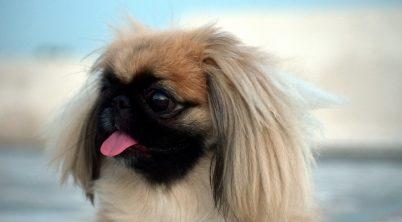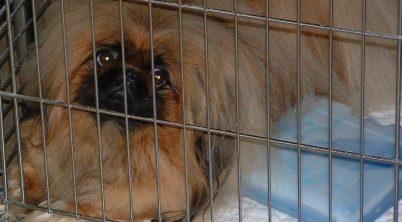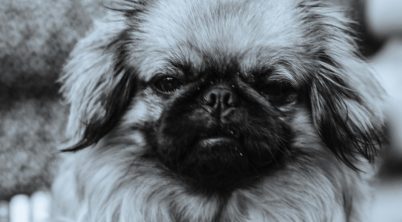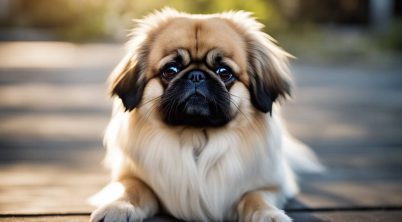Pekingese puppies are a toy breed with an illustrious history that traces back to ancient China, where they were treasured by royalty and often referred to as the “lion dog” due to their bold and confident appearance. They carry themselves with a regal bearing reflecting their aristocratic heritage, and despite their small size, they exhibit a self-assured demeanor. As puppies, they display a playful and affectionate nature, making them charming companions for those who appreciate their unique qualities.
The Pekingese is characterized by its distinctive flat face, a large set of expressive eyes, and a luxuriant mane of fur, which can come in various colors and patterns. This toy breed may be small, but it requires careful attention when it comes to grooming. Their thick double coat sheds and will need regular brushing to prevent matting. Pekingese puppies are particularly sensitive to heat due to their short muzzles, so it is important for owners to monitor their environment and ensure they remain cool and hydrated.
While they are not as high-energy as some other breeds, Pekingese puppies still require daily exercise to maintain their health and happiness. However, their exercise needs can be met with short, gentle walks and some playful indoor activities. Their size and moderate activity level make them suitable for apartment living, provided they have opportunities to play and explore safely. New Pekingese owners should be prepared for the breed’s vocalizations, as they are known to snort and snore, adding to their endearing charm.
About Pekingese Puppies
The Pekingese is a toy breed with a regal origin, having been developed to serve as loyal companions to the Chinese imperial family. These puppies are typically characterized by their distinctive lion-like mane, flat faces, and large, expressive eyes. The Pekingese moves with a unique rolling gait and carries itself with a dignified posture.
Physical Attributes
- Size: Small; generally weighing up to 14 pounds as adults.
- Coat: Long, double-coated, requiring regular grooming.
- Color: Various shades including gold, red, sable, cream, and black.
Temperament
- Known for being affectionate and loyal to their families.
- They tend to be reserved with strangers and can exhibit a strong-willed demeanor.
- Pekingese puppies are often described as being alert and can serve as good watchdogs due to their vigilant nature.
Health & Care
- The breed is prone to certain health issues such as brachycephalic syndrome, due to their flat faces, which can lead to breathing difficulties.
- They often make snorting and wheezing sounds and need to live in cooler environments to avoid overheating.
- Regular vet check-ups are recommended to monitor their well-being.
Training
- Pekingese puppies can be challenging to train due to their independent nature.
- Consistency and positive reinforcement techniques are essential in their training regimen.
Pekingese puppies, with their strong personality traits and specific care needs, make for companions that are suited to owners who appreciate the breed’s history and can dedicate time to their grooming and care.
Breed Origin and History
The Pekingese is a breed of great antiquity from China, believed to date back over 2,000 years. Its origin is intertwined with the imperial families, where it was held in high esteem by Chinese emperors. They are often associated with Buddhist lore, particularly the legend of the lion that shrank to the size of a small dog at the will of the Buddha.
In the late 19th century, Pekingese were introduced to England. After the British overtook the Chinese Imperial Palace in 1860, they returned with several of the dogs. One of these dogs was presented to Queen Victoria, marking the breed’s introduction to the West.
- Heightened Status in China: Favoured by royalty, these dogs were considered a symbol of good fortune and exclusivity, often found in luxurious settings within the Forbidden City.
- Physical Characteristics: They are distinguished by their thick coat and lion-like appearance, reminiscent of the mythical Chinese guardian lions.
- Expansion to the West: Post-introduction to England, the breed’s popularity spread rapidly among Western dog enthusiasts.
- Breed Recognition: The Pekingese is recognized by canine organizations worldwide, including the American Kennel Club, which categorizes it as part of the toy group.
This breed’s royal heritage and unique history contributes to their confident and dignified temperament, still making them a cherished companion today.
Physical Traits and Appearance
The Pekingese, a compact and stocky toy breed, carries a distinctive lion-like appearance, characterized by a lush double coat and a notably flat face, known as a brachycephalic feature. They possess a boldness that belies their small stature, often exuding an aura of self-importance.
Coat and Colors: The breed’s coat is long and flowing, available in a spectrum of colors including tan, red, gold, sable, black, white, cream, and gray. Patterns may vary, adding to their unique appeal.
| Coat Characteristic | Description |
|---|---|
| Texture | Thick double coat with a profuse mane, contributing to its regal bearing. |
| Length | Long, necessitating regular grooming to maintain its condition. |
| Variety | Solid or with patterns, presenting a diverse visual range. |
Facial Features: The Pekingese’s expressive eyes are set against the backdrop of their flat faces. Their muzzles are short, with a broad, flat nose enhancing their unique profile.
Body Structure: Despite its small size, the Pekingese has a well-built, stocky frame, with a sturdy body and a confident, rolling gait.
| Physical Aspect | Measurement |
|---|---|
| Height | 6-9 inches tall at the shoulder |
| Weight | Up to 14 pounds, with both males and females falling within this range |
Overall, they present a picture of compact might, with physical attributes that require consistent care and grooming to preserve their distinguished appearance.
Temperament and Behavior
The Pekingese breed embodies a distinct temperament characterized by regal dignity and a self-important outlook. These toy dogs exhibit a complex personality that harmonizes independence with staunch loyalty.
Personality Overview
The Pekingese boasts a personality rich in contrasts. It is known for its regal and dignified demeanor, reflecting its ancient lineage back to the Chinese imperial courts. Despite their small size, Pekingese dogs are courageous and have a self-important air about them. They’re not just lapdogs; their alertness makes them excellent little watchdogs.
However, it’s important to note that their intelligence comes with a stubborn streak. This stubbornness can make training a challenge, requiring patience and consistency.
- Independent: Pekingese are known for their self-sufficient temperament which can at times translate to aloofness.
- Loyal: Their devotion to their owners is unwavering, often forming strong, affectionate bonds.
- Intelligent: They have the capability to learn quickly but may choose when to demonstrate their intelligence.
- Watchdog Abilities: Despite their size, they are vigilant and will bark to alert their owners of anything unusual.
Pekingese and Companionship
In a home environment, Pekingese thrive on companionship, cherishing time spent with their family. Their affectionate nature makes them charming companions, though they prefer respect to rough play.
The breed’s complex personality can be summarized as:
- Affectionate: They are loving and enjoy being close to their owners, often seeking out laps or soft pillows.
- Loyal to the Core: Pekingese dogs are fiercely loyal, making them steadfast companions.
- Recognition of Ancestry: They carry themselves with a regal bearing, always conscious of their imperial roots.
With the right approach to training and socialization, these characteristics mold the Pekingese into a well-balanced, amiable pet.
Health and Care
Pekingese puppies, known for their long, luxurious coats, require regular grooming to maintain their distinct appearance and prevent matting. Owners should brush their Pekingese at least once a week to remove knots and tangles, paying extra attention to areas prone to matting, such as behind the ears and under the legs. The breed’s shedding is moderate, but regular grooming helps manage it effectively.
Health Issues: Pekingese are brachycephalic, meaning they have short nasal passages and flat faces. This anatomy can lead to brachycephalic syndrome, a condition that affects their breathing and makes them prone to overheating. Owners must watch for signs of respiratory distress, especially in hot or humid weather.
- Exercise Needs: While their energy level is typically moderate, Pekingese puppies do need daily exercise for their health and well-being. Short walks and play sessions of moderate intensity suffice, but owners should be cautious not to over-exert these small dogs.
- Health Care: Regular veterinary check-ups are important to monitor for common health issues, including eye problems and skin conditions. Feeding a well-balanced diet and maintaining a healthy weight are crucial to avoid additional health complications.
- Maintenance: The breed’s large, expressive eyes require careful cleaning to avoid tear stains and infection. They also need their fur around the facial wrinkle to be kept clean to prevent skin irritation.
In summary, Pekingese puppies thrive with consistent care and attention to their grooming and health needs. It’s essential for owners to be gentle, attentive, and vigilant, ensuring these regal canines lead a comfortable, healthy life.
Adopting a Pekingese Puppy
When considering the addition of a Pekingese puppy to the family, adopting from a shelter or rescue organization is a commendable option. Adopting a Pekingese ensures one is providing a forever home to a dog that may have been abandoned or surrendered.
Cost: Adoption fees typically cover spaying or neutering, first vaccinations, and microchipping. The average cost to adopt is around $300, which is considerably less than purchasing from a breeder.
Rescue Groups: Specialized groups often have Pekingese puppies and adult dogs available for adoption. These organizations ensure that the dogs are in healthy condition and will usually require a home visit and references to guarantee a safe and suitable environment.
Shelter Adoption: Local animal shelters may sporadically have Pekingese puppies, although rescue groups often take toy breeds quickly. Prospective adopters should check shelters regularly and consider setting alerts for new Pekingese arrivals.
Characteristics and Ownership
- Breed Traits: Pekingese are recognized as confident and self-assured companion dogs. Their historical background as lapdogs to Chinese royalty has imbued them with a dignified demeanor.
- Sleeve Dogs: The term “sleeve dog” refers to the smallest individuals of the breed, aptly named for their size small enough to fit within the voluminous sleeves of ancient Chinese garments.
- Ideal Owners: A Pekingese requires affection and appreciates being a part of daily activities. They are loyal and protective, making them suitable for those who can provide attention, although they may not be ideal for homes with very young children.
By adopting a Pekingese, an individual not only gains a loyal companion but also contributes positively to the broader effort in supporting rescue and shelter operations.
* Banner photo by GeekAtHeart, cropped | Some rights reserved

